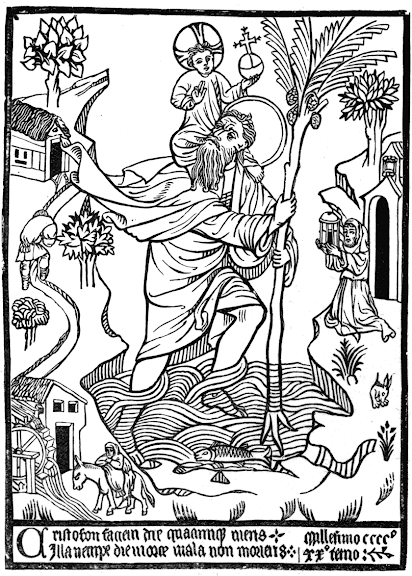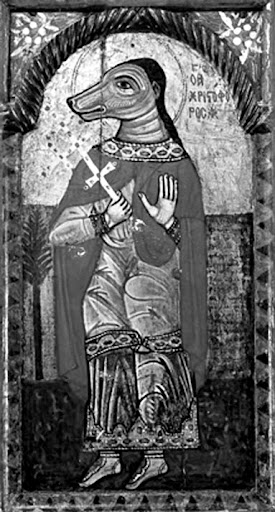
In legend, St. Christopher is remembered as a giant of a man described as being anywhere from 12 to 18 feet tall and sometimes described as having the head of a dog. These are loaded descriptions to impart attributes of Power, Respect, Geography and Loyalty.
These descriptions also echo aspects of the Greek (giants) and Egyptian (Set, Anubis) pantheons. A legitimizing effect of early Christianity was in comparing it's saints with those ancient preexisting religions. Many accounts describe Caananites (in modern day Lebanon) as doglike or canine. This not unlike the beast headed deities of nearby Egypt.
St. Christopher, himself, was born as Reprobus in Canaan anywhere from 200-225 AD during Roman rule.
Later to be known as the patron saint of travelers, St. Christopher is said to have wandered the ancient world searching for a master. As Reprobus, he first enrolled himself in the court of a fearsome Middle Eastern king. After fighting as a soldier, he left the king's service after he saw his master cross himself at the mention of the Devil's name. Reprobus sought the Devil that this great king feared.
Reprobus came upon a group of bandits whose leader proclaimed himself the Devil. While traveling with the bandits Reprobus watched as the thieves and their leader cowered before a crucifix on the roadside. Reprobus parted company with the Devil determined to find the man who made the Devil himself cower.
| "You had on your shoulders not only the whole world but Him who made it. I am Christ your king..." |
| - from The Golden Legend by William Caxton, 1483 |
Wandering in the wastes, Reprobus met a hermit named Certes who eventually instructed him in the Christian faith. After being baptized as Christopher by Certes he asked the hermit how he could serve Christ, the man whose name was invoked by kings and made thieves and devils tremble.
 Certes the hermit suggested fasting and prayer, Christopher replied that he was unable to perform that service. The hermit suggested that because of his size and strength Christopher could serve Christ by assisting people to cross a dangerous river nearby.
Certes the hermit suggested fasting and prayer, Christopher replied that he was unable to perform that service. The hermit suggested that because of his size and strength Christopher could serve Christ by assisting people to cross a dangerous river nearby. This is a loaded section of the legend. First, river-crossing can apply to obstacles both real and metaphorical. Christopher had crossed many rivers within himself as he traveled searching for a master. Second, there were no city departments in the ancient world. No one was regularly building or maintaining bridges in the hinterland.
Third, there very few official churches in the 3rd Century. This was still an "underground period" for Christianity. A priest had to carry his church with him on his back. Fourth, this tale takes place between the underground period and the proclamation of Christianity was de-criminalized in the 4th Century by Constantine (Edict of Milan February 313 AD)- bridging the gap between the two very different times.
Much help was needed at this point in history... so Christopher accepted.
After he had performed this service for some time, a little child asked him to take him across the river. During the crossing, the river rose and the child seemed to grow much heavier. Christopher's strength was tested and he found himself in danger of drowning. When he finally reached the other side of the river, he said to the child: "You've put me in the greatest danger. I do not think the whole world could have been as heavy on my shoulders as you were."
The child replied: "You had on your shoulders not only the whole world but Him who made it. I am Christ your king, whom you are serving by this work." The child then vanished.
Eventually Christopher traveled to the city of Lycia, in the southern coast of Turkey, Christopher spoke with local Christians there who were being martyred by Roman law. He was brought before the local king, called Dagnus, who demanded that Christopher sacrifice animals to the local pagan gods. Not to do so would make him a criminal according to Roman law.
Christopher is said to have replied: "...thou art the death of the world, and fellow of the devil, and thy gods be made with the hands of men." No hidden meanings in the story this time. In no uncertain terms, and facing death, Christopher was true to his master.
| "...thou art the death of the world, and fellow of the devil, and thy gods be made with the hands of men." |
| - from The Golden Legend by William Caxton, 1483 |
King Dagnus, still trying to ally with Christopher, then tried to bribe him with a promise of riches and two beautiful women. Much to Dagnus's dismay, Christopher converted these women to Christianity and refused the bribe. Finally, Dagnus ordered all three of them to be decapitated.
St. Christopher was martyred during the reign of the Roman Emperor Decius about two-hundred years after Jesus Christ. Decius, himself, would rule the empire for just two years before being killed in battle. During his brief reign, Decius issued edicts demanding the blood of Christians - especially leaders like St. Christopher. According to history, Christopher suffered and died as a martyr in the second year of Decius on July 21st 251 AD.
References:
Wikipedia, Saint Christopher
Sir Thomas Brownes' Vulgar Errors V.xvi, Of St. Christopher
The Golden Legend, The Life of Saint Christopher

No comments:
Post a Comment